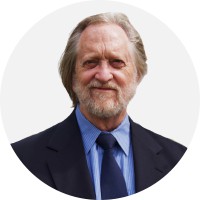The views expressed in our content reflect individual perspectives and do not represent the authoritative views of the Baha'i Faith.
Aristotle famously wrote about “horror vacui,” the principle commonly translated as “nature abhors a vacuum.”
While we can artificially create a vacuum, it must be done under carefully controlled conditions, and maintaining it against nature’s tendency to restore some kind of balance requires effort.
In his Tablet of the Universe, Abdu’l-Baha made a number of statements on the nature of material reality—and some of them may surprise you.
Regarding the question about the possibility of a void or a vacuum in nature, Abdu’l-Baha observed that:
… these great orbits and circuits [of celestial bodies] fall within subtle, fluid, clear, liquid, undulating and vibrating bodies, and that the heavens are a restrained wave because a void is impossible and inconceivable. – anonymous provisional translation, p. 4.
He then went on to note that whether we ascend to ever more encompassing compositions or descend to ever more minuscule particulates, we discover essentially the same universal laws at work and the same governing principles of composition:
All that may be said is that the celestial bodies and the ethereal bodies differ in respect of some of the substances and elements from which they are constituted, the quantities and proportions of these that go into their composition, the peculiar characteristics that give rise to the difference in the outward effects of these bodies, and the properties that emanate from them in rich abundance. – Ibid.
In that same tablet, Abdu’l-Baha also noted that particulate matter is reducible to a stage of refinement where it has no properties of weight or mass, something the physicists of his day had not yet conceived:
The celestial bodies that surround the material bodies also differ one from another in respect of subtlety, fluidity, and weight. It cannot be otherwise, for a void is impossible. The existence of a container implies the existence of something contained; what is contained can hardly be other than a body but the bodies of the celestial spheres are in the utmost degree of subtlety, lightness and fluidity as bodies may be of diverse kinds solid-like rocks, malleable-like metals and minerals, fluid-like water and air. Lighter still they may be of a kind that ascends heavenwards, such as that which is used in dirigibles; and lighter than all of these are fire, electricity and lightning. All of these are bodies in reality, but some of them are weightless. – Ibid.
In sum, according to Baha’i theory, there is no void in the material universe. Every created entity is composite and exists in a “sea” of materiality more refined than itself. Were it otherwise, chaos would ensue.
For example, if a photon had rest mass, then according to Einstein’s discovery of the relationship between energy and mass, the mass of the photon would approach infinity as the photon approached the speed of light, thereby possibly destroying whatever it enlightened.
Here’s the most amazing part of all this: as we approach infinity in the refinement of particulates, the microcosm increasingly emulates the properties of spiritual reality, a reality in which nothing is composite. Or, to compare this process of refinement to the process of refining the human soul in its ascent, materiality can become ever more refined without ever changing state and becoming spiritual (i.e., non-composite) because within the state or condition of being material there is infinite refinement. Therefore, that which is material can never become non-composite—everything material must compose and eventually decompose.
In this sense, physical creation is not an event, but a systematic, ongoing process without beginning or end, except in relative terms–relative to particular compositions within the overall system of particular planets, galaxies, etc.
Stated simply, if the creation of a system capable of producing human beings is the goal of an eternal God, then such a system must always have existed—since the idea for such a process is pre-existent and since the idea itself emanating from the Divine Will is causative:
… all things have emanated from God; that is, it is through God that all things have been realized, and through Him that the contingent world has come to exist. The first thing to emanate from God is that universal reality which the ancient philosophers termed the ‘First Intellect,’ and which the people of Baha call the ‘Primal Will’. – Abdu’l-Baha, Some Answered Questions, newly revised edition, p. 235.
Thus, clearly creation did not start with the inception of our particular planet, nor even with our galaxy nor with all we can observe or will ever observe. By definition, then, while all parts of the universe are in a state of constant change, all “closed” systems are relative except the universe itself, which, like a body that has always existed and will never die, contains sub-systems that function with a degree of autonomy, but contribute to the whole, even as cells in the body:
… this endless universe is like the human body, and … all its parts are connected one with another and are linked together in the utmost perfection. That is, in the same way that the parts, members, and organs of the human body are interconnected, and that they mutually assist, reinforce, and influence each other, so too are the parts and members of this endless universe connected with, and spiritually and materially influenced by, one another. For example, the eye sees and the entire body is affected; the ear hears and every limb and member is stirred. Of this there is no doubt, for the world of existence is also like a living person. – Ibid., p. 285.
This same axiom can be applied to the concept of social unity and systems in the following manner. For now, the largest “unity” we can appreciate is a global polity, though in science fiction we commonly accept the existence—and, often, the desirability—of social structures consisting of interplanetary or intergalactic federations. But as we reflect and pray, we can mentally praise the Creator for the majesty and synchronicity of the entire universal body. In fact, there are several passages in the Baha’i writings that hint at a future in which the concept of the unity of humankind will, in time, reach beyond the confines of our blue marble island:
Every heart is filled with wonder at so bewildering a theme, and every mind is perplexed by its mystery. God, alone, can fathom its import. … Know thou that every fixed star hath its own planets, and every planet its own creatures, whose number no man can compute. – Baha’u’llah, Gleanings from the Writings of Baha’u’llah, p. 162.
You May Also Like
Comments

















(Abdu'l-Baha, Selections from the Writings of Abdu'l-Baha, p. 194)